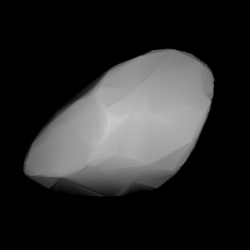 Modelled shape of Swetlana from its lightcurve | |
| Discovery [1] | |
|---|---|
| Discovered by | G. Neujmin |
| Discovery site | Simeiz Obs. |
| Discovery date | 15 August 1917 |
| Designations | |
| (882) Swetlana | |
Named after | unknown [2] |
| A917 PB ·1967 TQ 1917 CM | |
| Orbital characteristics [3] | |
| Epoch 31 May 2020 (JD 2459000.5) | |
| Uncertainty parameter 0 | |
| Observation arc | 102.46 yr (37,424 d) |
| Aphelion | 3.9571 AU |
| Perihelion | 2.2903 AU |
| 3.1237 AU | |
| Eccentricity | 0.2668 |
| 5.52 yr (2,016 d) | |
| 151.70° | |
| 0° 10m 42.6s / day | |
| Inclination | 6.1256° |
| 256.30° | |
| 126.44° | |
| Physical characteristics | |
| 29.867±0.009 h [9] | |
| 10.7 [1] [3] | |
882 Swetlana (prov. designation: A917 PBor1917 CM) is a dark background asteroid from the outer region of the asteroid belt. It was discovered on 15 August 1917, by Russian astronomer Grigory Neujmin at the Simeiz Observatory on the Crimean peninsula. [1] The X-type asteroid has a longer-than average rotation period of 29.9 hours and measures approximately 42 kilometers (26 miles) in diameter. The origin of the asteroid's name remains unknown. [2]